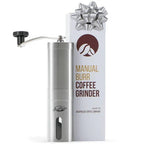Coffee’s final sensory experience is its aftertaste. It’s the last thing you’ll remember once your mug is empty. It’s the moment that leaves a lasting impression in your memory.
This is the final tasting element we’ll discuss in this Coffee Tasting Series. I’ve left it for the end because it’s an experience that is heavily influenced by all the other tasting elements we’ve discussed. If you haven’t been keeping up, I suggest you head toward the beginning of this series.
- How To Taste Coffee: Start Here
- Acidity
- Sweetness
- Bitterness
- Aftertaste <- you are here
- Mouthfeel
- Aroma
After you’ve read this, you’ll be ripe and ready to taste like a professional - with a bit of practice, of course.
How Your Coffee's Aftertaste Forms
A coffee’s aftertaste is largely the product of all the other sensory elements you find in each sip. When you swallow, all these elements mingle to form the thing we call aftertaste.
Acidity in the aftertaste can be crisp and bright, or mellow and clean. It can cause an aftertaste to linger for ages or disappear quickly. If the coffee is under extracted, you’re drinking espresso, or it just happens to be a really acidic bean, you may feel a light burn that travels down your throat.
Sweetness is a great thing to find in the aftertaste. A coffee that goes down with a pleasant sweetness is probably going to leave a hint of that sweetness there for you to enjoy for a while. Think of how your throat feels sweet and clean after a bite of fresh cake.
Bitterness is rarely something you want to experience in your coffee’s aftertaste. More often than not, it’s harsh and biting. It can even create a slight scratchy feeling as you swallow. Generally, a highly bitter aftertaste is the result of over roasting or over extraction.
Read: How To Pair Your Coffee Brewer With Its Perfect Grind Size
Aromas provide the most flavor in our total coffee experience, and that still rings true in the aftertaste. When you swallow coffee, the aromas rise up to your retro nasal passages where your brain interprets them as flavors. If your coffee’s aftertaste has a distinct flavor, it’s most likely from the aromas.
Mouthfeel rarely contributes to aftertaste as intensely as the other elements we’re discussing because your throat doesn’t pick up on mouthfeel as well as your tongue. However, coffees with particularly distinct feelings can still be noticeable, especially if they have a heavy creamy body or sweet juicy one.
When you taste your next cup of coffee, pay attention to these tasting elements individually, then pay attention to how they all impact the aftertaste. Sometimes only one or two of the elements characterize the aftertaste, but sometimes all of them play a role in creating that final moment.
How To Describe Coffee Aftertaste
The best way to experience a coffee’s aftertaste is to breath out deeply and slowly as you swallow. This allows the liquid elements to drift down the back of your tongue and throat without your esophagus muscles interrupting your experience. It also allows the rising aromas to flow up and out gently and with clarity.
When you do this, ask yourself the magic tasting question: What does this remind me of?
You can approach describing aftertaste several ways, but my favorite involves a few simple questions to get the ball rolling. These questions provide a quick way to assess the aftertaste without having to dive deep into each of the tasting elements. They allow you to touch the highlights, but still get a good reading on what the aftertaste is like overall.
Read: How Much Should You Pay For Coffee Beans?
1. What sensory elements contribute most to the aftertaste?
If the aftertaste is wildly bitter or acidic, take note. Maybe the most noticeable element is a rich, refreshing sweetness. Maybe the aromas are powerful and flavorful. Whatever one or two elements stick out the most, keep them in mind.
2. Is there a dominant flavor that characterizes the aftertaste?
The aftertastes of some coffees don’t have much of a flavor. It doesn’t mean they’re bland or of poor quality - they just don’t have a aroma that is very powerful.
Most coffees, however (if they are freshly roasted and ground), will give you plenty of aromas to enjoy and think about during the aftertaste. Do you experience any flavor in the aftertaste that characterizes the experience?
3. Does the aftertaste change at all?
Many coffees have an aftertaste that changes slightly as the coffee goes down. Sometimes it starts out with with a simple sweetness that evolves into a rich flavor as the aromas rise. Sometimes it starts with a mellow acidity that turns into a bright and tangy one as the acids reach more tender skin.
Read: Why Fresh Coffee Is The Best Coffee
4. Does the aftertaste linger at all?
When your coffee has been grown, roasted, and brewed with expert precision all the way through its journey, it’s probably going to feature an incredible aftertaste that lingers for ages. Balanced coffee tends to do this, which makes for a great coffee experience that keeps giving once the mug is empty.
Under extracted coffee is likely to produce a short, disappointing aftertaste that only leaves a bit of a sting. Over extracted coffee will probably leave you with a heavy, dark bitterness for a short while after each sip.
When you put these questions together, you end up with aftertaste descriptions like these:
- A bright and floral coffee from Panama that features a crisp and tingly aftertaste with a rich flowery aroma that’s reminiscent of a walk across a flower-cover field.
- An earthy Rwanda with a dark chocolate and spice aftertaste that’s complimented by a brief woodsy aroma.
- One of my favorites, naturally processed Ethiopian coffees, tend to have a loud fruity aftertaste with a lingering, pleasant sweetness and mellow acidity.
Read: How To Host A Coffee Cupping (Tasting)
---
I’ve given you everything I have to offer on tasting throughout this series. I’ve told you everything I know. But the journey isn’t over.
It’s time for you to put your new knowledge into practice. It may be difficult at first, but don’t give up. The reward is well worth the effort. Taste everything with focus. Find the nuance in ordinary things. Never stop exploring and don’t be afraid to push the boundaries of your palate to explore new realms of flavor.
Never forget:
Learning to taste coffee when you're using older, low-grade beans is extremely hard. Learning to taste coffee when your beans are uber-fresh and from prestigious farms is easy!



